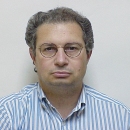
Plenary Lecture
On Efficient New Schemes for Integrating Pattern Classifiers based on Similarity Analysis of Robust hierarchical Features

Professor Dimitrios A. Karras
Dept. Automation, Hellas
Chalkis Institute of Technology
Greece
E-mail: dakarras@ieee.org
Abstract: In pattern recognition applications the features are extracted using a Feature Extraction Method (FEM), which produces a suitable set of features of the desired pattern, according to the requirements of each particular application. The selection of the appropriate FEM for a considered application depends on the specific conditions and requirements, in order to achieve the higher classification efficiency. To this end, it is essential in demanding applications to use a combination of different FEMs involving efficient cooperaration and mixture schemes. The underlying idea is that multiple FEMs contribute different features of the same pattern that correspond to different levels of importance, conveying different important information.
After a critical overview of pattern classifiers mixture appreoaches, this plenary speech aims at outlining a novel methodology for combining the classification decisions of different neural network as well as different pattern recognition techniques. Instead of the usual approach for applying voting schemes on the decisions of their output layer neurons, the proposed methodology integrates robust higher order features extracted by their upper hidden layer units. More specifically, different instances (cases) of each such classifier, derived from the same training process but with different training parameters, are investigated in terms of their higher order features, through similarity analysis, in order to find out repeated and stable higher order features. Then, all such higher order features are integrated through a second stage neural network classifier having as inputs suitable similarity features of them. The herein suggested hierarchical neural system for pattern recognition shows improved classification performance in computer vision tasks. The validity of this novel combination approach has been investigated when the first stage neural classifiers involved correspond to different Feature Extraction Methodologies (FEM) for shape classification. The experimental study illustrates that such an approach, integrating robust higher order features through similarity analysis of a committee of the same classifier instances (cases) and a second stage neural classifier, outperforms other combination methods, like voting combination schemes as well as single neural network classifiers having as inputs all FEMs derived features. In addition, it outperforms hierarchical combination methods non performing integration of cases through similarity analysis.
Brief Biography of the Speaker: Dimitrios A. Karras received his Diploma and M.Sc. Degree in Electrical and Electronic Engineering from the National Technical University of Athens, Greece in 1985 and the Ph. Degree in Electrical Engineering, from the National Technical University of Athens, Greece in 1995, with honours. From 1990 and up to 2004 he has collaborated as visiting professor and researcher with several universities and research institutes in Greece. Since 2004, after his election, he has been with the Sterea Hellas Institute of Technology, Automation Dept., Greece as associate professor in Digital Systems and Signal Processing as well as with the Hellenic Open University, Dept. Informatics as a visiting professor in Communication Systems (the latter since 2002 and up to 2010). He has published more than 60 research refereed journal papers in various areas of pattern recognition, image/signal processing and neural networks as well as in bioinformatics and more than 160 research papers in International refereed scientific Conferences. His research interests span the fields of pattern recognition and neural networks, image and signal processing, image and signal systems, biomedical systems, communications, networking and security. He has served as program committee member in many international conferences, as well as program chair and general chair in several international workshops and conferences in the fields of signal, image, communication and automation systems. He is, also, editor in chief of the International Journal in Signal and Imaging Systems Engineering (IJSISE), academic editor in the TWSJ, ISRN Communications and the Applied Mathematics Hindawi journals as well as associate editor in various scientific journals. He has been cited in more than 1000 research papers, his H/G-indices are 12/25 and his Erdos number is 5. His RG score is 28.09.